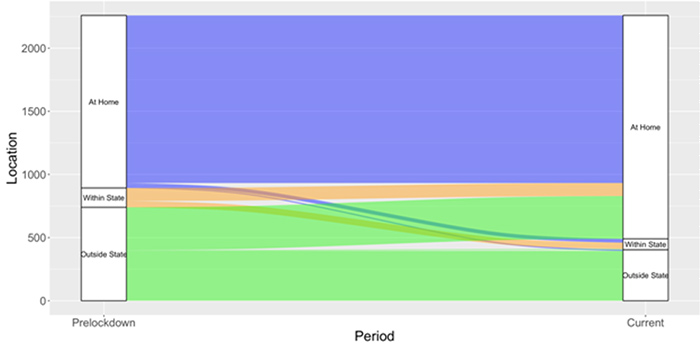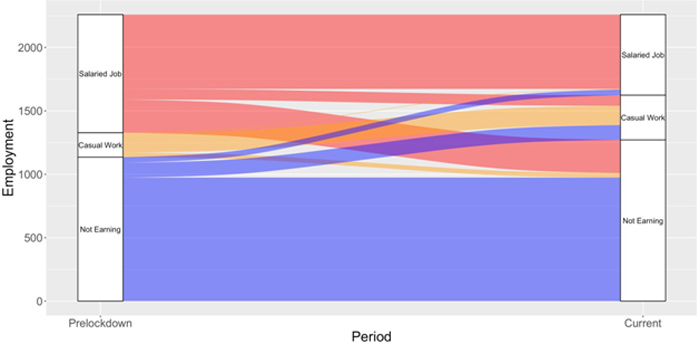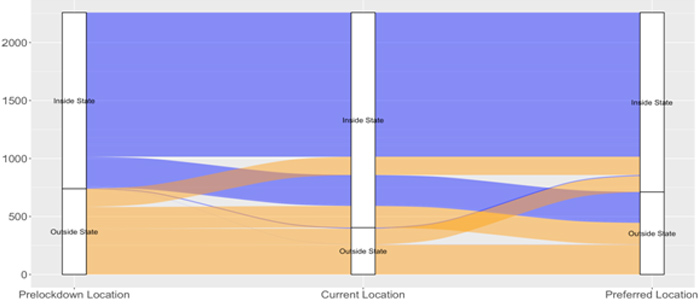The nationwide lockdown in India hit migrant workers particularly hard and once travel restrictions were lifted, 11 million interstate migrants returned home. In this note, Chakravorty et al. present key findings from a phone survey of youth from Bihar and Jharkhand who were previous trainees of ‘Deen Dayal Upadhyay Grameen Kaushalya Yojana’. The survey seeks to assess the impact of the lockdown on interstate migrant workers, and to gauge their willingness to migrate again in the future.
The nationwide lockdown in India – the shutdown of businesses, factories, and other workplaces – affected the livelihoods of millions of people across the country. Migrant workers were hit particularly hard, as many of them lost their jobs, with no social safety net to fall back on, and little access to family support. Interstate travel was initially banned, and the media reported on desperate migrants walking back home for hundreds of kilometres. Once travel restrictions were lifted, 11 million interstate migrants went home.
In this note, we detail seven main findings of a phone survey conducted with 2,259 youth from Bihar and Jharkhand in June and July 2020. All respondents were previous trainees of a 3-6 month residential training during 2019-2020 under DDU-GKY (Deen Dayal Upadhyaya Grameen Kaushalya Yojana), a skill-based training programme that places disadvantaged rural youth into formal salaried jobs in manufacturing and services, often located in urban areas in other states. The objective of the survey was to assess how the nationwide lockdown affected interstate migrant workers, and to gauge their willingness to migrate again in the future.
Finding 1: Nearly half of all interstate and intrastate migrants returned home
Nearly half (45%) of the respondents who resided outside of their home state in the pre-lockdown period (interstate migrants) had returned to their home state, indicative of the ‘return migration’ that the nationwide lockdown initiated. In addition, 44% of intrastate migrants, that is, those that resided somewhere within their home state but not at home when the Covid-19 crisis hit, had returned home when we surveyed them. The large majority of respondents who were at home before the lockdown continued to stay at home in June and July 2020.1
Figure 1. Location, pre and post lockdown
Finding 2: A third of migrants in salaried jobs became unemployed, and of those that remained in jobs, about a third were on unpaid leave
Nearly a third of respondents (32%) that had a salaried job in the pre-lockdown period had lost their job. At the same time, the proportion of respondents doing casual work increased from 9% to 16%. Of the respondents that had lost their job (296 in number), nearly half (47%) said that they had left their jobs voluntarily, 23% said that they had lost their jobs as offices were closed because of the lockdown, and 9% had come home during the Holi vacation preceding the lockdown and could not go back to work due to the halt on interstate travel. Of those that remained in salaried employment (634 in number), 37% were on leave (12% were asked by employers not to come, 62% because the office was closed due to lockdown, and the rest voluntarily decided to be on leave) and most of them were not paid. This indicates high levels of precariousness, even among those who were still in formal employment.
Figure 2. Employment, status pre and post lockdown
Finding 3: Less than a third of the migrants still employed received support from their employers and few withdrew money from their PF account
Of the migrants who were still in employment in June and July 2020 (459 in number), only 31% had received support from their employers, mainly in the form of food supplies. One of the relief measures introduced by the central government was a relaxation in the clauses of Provident Fund (PF) withdrawal, where people could now withdraw 75% of their PF funds or three months’ basic wages (whichever was less). Of the respondents who were in formal employment before the lockdown (931 in number), only 4% actually withdrew money from their PF accounts. A majority of respondents were simply not aware that they had PF benefits attached to their job, let alone that they could withdraw from their PF accounts.
Finding 4: Half of interstate migrants received support from the government
Of all interstate migrants, about half (51%) received government assistance, mainly in terms of financial aid and food supplies. Of the interstate migrants who did not go back home 395 in number, only 27% received support from their family members. Most of this support was in the form of financial assistance and loans with or without interest. The ‘Aapda’ programme, an app-based social assistance programme through which migrants from Bihar located in other states could self-register and receive Rs. 1,000 cash transfer to their personal accounts, reached 61% of the Bihari interstate migrants who did not go home. These number reflects both the significant policy efforts made to help migrants, and their limitations in terms of providing universal coverage.
Finding 5: Nearly a third of migrants did not receive any support from any source, and their daily food intake reduced
Nearly a third (31%) of interstate migrants did not receive any support from any source (that is, the government, employer, or community organisations). As a result, 31% of migrants reported that their daily food-intake was less than usual, indicating high levels of food insecurity among the migrant population.
Finding 6: Respondents reported higher levels of anxiety and lower levels of life satisfaction vis-à-vis pre-lockdown
We asked respondents to score their level of life satisfaction and anxiety on a scale from 0 to 100. These questions were also included in a previous survey round before April 2020 (May 2019-March 2020). Average anxiety levels among respondents in the post-lockdown period were higher than what was reported in the pre-lockdown survey (44 versus 37). Average levels of life satisfaction among the respondents were lower in the post-lockdown period as compared to the pre-lockdown levels (65 versus 73).
Finding 7: Among the migrants that returned home, the willingness to re-migrate is substantially lower among females as compared to their male counterparts
We asked respondents how willing they were to live outside of their home state in the future. Among the migrants who were outside their home state before the lockdown and continued to stay outside at the time of survey, 65% preferred to continue living outside their home state in the future. Among those who had returned home, 54% wanted to re-migrate out of their home state. The willingness to re-migrate was substantially lower among female former migrants (37%) as compared to their male counterparts (68%), which suggests that it might be more difficult to re-integrate female migrant workers back into the labour market.
Figure 3. Preference of migration, pre and post lockdown
Policy implications
These seven findings are in line with the widespread observations of the job losses and the ‘return migration’ caused by the Covid-19 crisis, and call for urgent policy action along two dimensions. First, migrants need to be protected by safety nets where they live and work, not where their families are. This protection cannot be only legislated – to be effective, it needs to be coupled with efforts to actually enrol migrants into social programmes. Second, migrant workers – and especially women – need structured support for their re-integration into the labour market.
Note:
- The respondents of this survey are a part of the sample enrolled in our previous study, involving a randomised controlled trial that seeks to examine the impact of job prospect information on job retention in DDU-GKY participants in 2019-2020 (Chakravorty et al. 2020).




 05 November, 2020
05 November, 2020 










Comments will be held for moderation. Your contact information will not be made public.